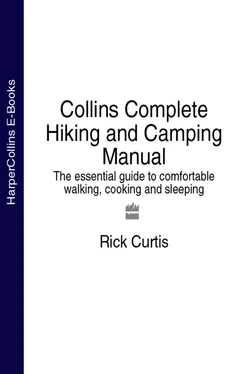Compressed Gas Stoves The fuel canister has a screw attachment on the top. The stove burner either screws directly onto the top of the canister or the burner sits on the ground off to the side and there is a flexible fuel tube that runs from the burner to the fitting on the canister. Once the canister is connected you simply turn the fuel knob to ON and light the stove.
Solid Fuel Stoves This varies from stove to stove depending on the type of solid fuel. With a pellet stove like the Esbit, the fuel pellets are flammable. You insert the pellet into the stove and light it. The pellets will light even when cold or wet.
Stove Safety Guidelines
Know how to operate a stove properly before you light it.
Make sure your stove has enough fuel before you light it.
When cooking on a stove, always work from the side where the on/off control is located. Never reach over the stove to work on it or put your face or body directly over the burner.
Do not overfill a liquid fuel stove.
A windscreen will help the stove work more efficiently and save fuel as well as keep the flame from being blown out.
If using a stove with a separate fuel bottle, make sure that the fuel bottle is designed to hold pressure (such as MSR bottles). Also make sure that the bottle is in good shape. I’ve seen plenty of banged and dented fuel bottles that I just don’t trust to hold pressure. These should not be connected to a stove.
Be careful if a hot stove goes out. Do not relight it until it has cooled down for at least 15 minutes. Priming a hot stove with fuel can result in instantaneous and violent ignition.
Never use a stove inside a tent, snow cave, or other enclosed or poorly ventilated space. Stoves give off carbon monoxide, which could lead to asphyxiation in a poorly ventilated area (see “ Carbon Monoxide,”).
Fuels should always be stored a safe distance from the stove when it is being used. Care should be taken to note the wind direction in relation to the fuel storage area so that fuel fumes cannot reach the flame source or sparks reach the fuel source. Always refill stoves far from any source of flame or heat.
What to Do if Your Stove Catches Fire
I’ve seen a number of models of stoves leak and catch fire. The first thing to do is to back away quickly. The best methods for putting out a stove fire are dousing with liberal amounts of water and dumping sand or dirt on the stove. If none of these is available you can also try tossing an empty pot over the stove. The hope is that lack of oxygen will put out the fire; however, the pot also concentrates the heat, which could cause a more violent ignition before the fire is extinguished.
Be careful with stove fuel and plastic pumps. Make sure that you don’t spill fuel on stoves with plastic pumps. If there is fuel on the outside of the pump while the stove is lit, it can catch fire. A fire on a plastic pump can melt the pump, allowing more fuel to flow out and ignite, a potentially explosive situation.
How Much Fuel to Bring
The amount of fuel you need depends on the size of your group and the type of items on your menu. Cooking at high altitude (see page), boiling water for purification, or melting snow for water will increase your fuel requirements. The following are guidelines for typical three-season trips cooking for breakfast and dinner:
WHITE GAS FUEL GUIDELINES
| Season |
Fuel/Person/Day |
| Summer |
1/ 6quart (157 milliliters) |
| Spring and fall |
1/ 4quart (236 milliliters) |
| Winter or at high altitude |
1/ 2quart (473 milliliters) if you need to melt snow for water |
USING A WHITE GAS STOVE
Operation
White gas stoves fall into two categories: those where the fuel bottle/pump is integrated with the burner and no assembly is required; and component stoves with a separate burner, pump, and fuel bottle, like the MSR Whisperlite, the Coleman Apex II, and the Primus Omni Fuel. Component stoves need to be assembled before use, and proper assembly is essential for safe stove operation.
Read the product literature that comes with your stove carefully for the latest instructions and information on how to assemble and use your stove properly. The following instructions are representative of component stoves and are based on MSR stove instructions with permission of MSR. Always follow the instructions that came with your stove, as this information may not be the most current.
Assembling the Stove
1 Fill an MSR Fuel Bottle to the marked Fill Line. Use only MSR fuel bottles. Non-MSR fuel bottles may result in fuel leakage and/or separation from the Pump. Fuel may ignite, possibly resulting in injury or death. (Make sure the bottle is not dented. Small holes can cause pressure loss or fuel leaks.)
2 When you open a fuel bottle the contents may be under pressure, so hold it away from you and others as you unscrew the cap so that fuel doesn’t spurt into your face.
3 Screw the Pump snugly into the Fuel Bottle. Make sure the Control Valve is all the way in the OFF (–) position.
4 Pump the Plunger until firm resistance is felt, 15 to 20 strokes if the Fuel Bottle is full, 40 to 55 pump strokes if the bottle is half full.
5 Check for any leaking fuel at any of the O-ring seals on the pump. Don’t light the stove if you see fuel leaks.
6 Lubricate the end of the fuel line with saliva or oil and insert the Fuel Line into the hole in the pump.
7 Snap the Catch Arm securely into the slot on the Pump. Failure to lock the catch arm can result in the fuel line and fuel tank detaching from the stove during operation, an extremely hazardous condition. I always teach “click and lock, ready to rock.” Don’t light the stove until the catch arm locks into place with a click.
8 Snap the pot support legs into place and put the stove on a suitable flat, insulated surface before lighting.
MSR Whisperlite White Gas Stove with Fuel Bottle, Pump, and Burner(Image courtesy of Mountain Safety Research)
Operating the Stove
Before lighting the stove make sure that:
The stove assembly has no fuel leaks.
The catch arm is locked and stove is properly assembled.
The area is clear of flammable material and spilled fuel.
Priming
The stove must be preheated or “primed” in order to operate properly. Insufficient preheating may result in flare-ups or poor performance.
1 Open the Control Valve and allow approximately 1 teaspoon of fuel to flow through the jet opening in the burner into the priming cup at the base of the burner. (Alcohol may be used as an alternate priming fuel to reduce soot buildup from the preheat process.) Note: Do not overprime. Do not fill the priming cup with fuel. Only a small amount of fuel is needed. Excess fuel can result in a dangerous flare-up.
2 Turn the Control Valve off.
3 Check for any leaks at the Control Valve, Pump, Jet, and Fuel Line. If leaks are found, do not use the stove.
4 Light the Priming Fuel.
5 Place the Windscreen around the stove. Make sure the pump and fuel bottle are kept outside the windscreen.
Turning the Stove On
1 When the preheating fuel has burned to a small flame or gone out completely, open the Control Valve gradually and light the stove at the burner. You should get a steady blue flame.
2 If the stove:• Goes out, turn the Control Valve off. Wait for the stove to cool and return to the “priming” step.• Burns with erratic yellow flame when you first start it, close the Control Valve and allow the stove to preheat longer. (Priming with a separate fuel source like a small squeeze bottle of alcohol is helpful here.)• Burns intermittently with yellow and blue flames, turn the Control Valve down but not off until the stove burns with a steady blue flame, then slowly turn the Control Valve up.
Читать дальше












